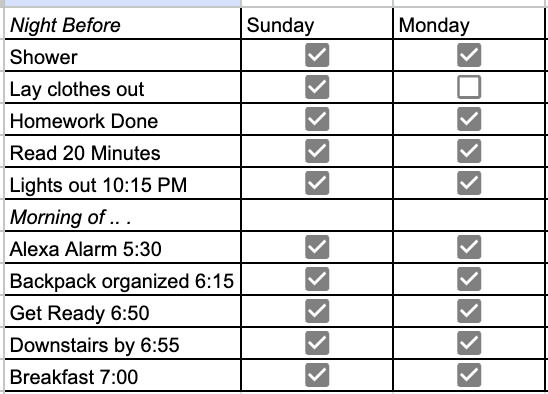Measure what Matters, Without Losing your Mind
Conventional wisdom: If you want to improve something, you have to measure it.
We agree…with a caveat.
There are a lot of cliches about measurement. “If you don’t know where you are, it’s hard to make a plan for where to go.” "What gets measured gets managed." And so on.
We do think that measuring — sleep, steps, homework completion, and so on — can be quite valuable, and even transformative.
But at RESET, we’ve seen all kinds of measurement problems. Parents try to track things like screen time, grades, or routines, but the numbers often cause frustration because they tell the wrong story, or an incomplete story.
Sometimes the data’s wrong because the tech malfunctioned. The watch breaks. Your son finds a loophole in your system.
So how do you actually use measurement to create change without it backfiring? Here are a few places we see measurement challenges come up, and what to do about them.
Our view is that good measurements should be simple. And if you’re arguing too much about the details, you’re probably losing. Choose one thing to track. Make it simple. Use it to start conversations. That’s how change happens.
Trickiest One - Screen Time
Screen time tracking sounds simple. But when we dig in, we inevitably see lots of challenges.
Take our client B. His parents check the screen time report, and it says he’s been on his phone for 7 hours 54 minutes and it's not even 9 AM yet.
But of course that number isn’t right. Sometimes the app keeps running in the background, inflating his time, while he sleeps. B is innocent!
Sometimes our other clients are … less innocent. They change the device’s time zone to reset limits. Or they watch YouTube or other media via iMessage previews. Or they delete and reinstall apps to restart app timers.
This "noise" compromises the whole conversation - parents don't want the time to dig in on every single report and sort out fact from fiction.
So no one trusts it, and suddenly the teen has a way out: “That’s not even accurate.” Parents throw up their hands.
Another issue? Multiple devices.
It’s not uncommon for a teen to have four or more different screens. A personal laptop. A phone. A school-issued Chromebook. An iPad. Some tracking tools can link Apple devices under one account, but what about the school computer?
As one of my clients put it:
“Yeah, sometimes I just watch YouTube on my school laptop, so my mom doesn’t count it against my screen time.”
That brings us to another problem: not all screen time is the same.
There’s the unproductive kind - doom-scrolling TikTok, snapping back and forth on Snapchat, cycling through notifications. And then there’s the productive kind: researching for a school project, watching a YouTube tutorial on how to crochet, using Spotify to help focus.
And sometimes, there’s gray area screen time. Is listening to music while doing homework helpful, or is it just another distraction? What about a kid watching a Netflix show to decompress after school? Is that “bad” screen time, or is that just… being a human being?
Parents we work with struggle with this distinction all the time, and schools don’t make it easier. More and more assignments are online, so kids are constantly switching between work and distraction.
If you struggle with executive function, just figuring out where an assignment was posted can feel like a game of detective work: Did my teacher put it in Google Classroom? Was it a handout? Did they even post it yet?
At RESET, we keep it simple: Before we get into the nuances of “good” vs. “bad” screen time, let’s just be on screens less, and do "offline stuff" more.
We can refine what that means over time.
Grades: What If the System Itself Works Against You?
Tracking grades seems straightforward.
Except ... Not all teachers update their gradebooks at the same pace.
Some post grades all the time: quizzes, small assignments, participation. These kids get tons of chances to bump up their grades.
Others? They post infrequent, spiky “blobs” of updates. You might go weeks with no new grades, and then suddenly, yikes, one big test drops and you’re stuck with a C.
Teachers don’t love it either.
Our client R for example has a Biology teacher who is posting things nightly. He went from completing 20% of his homework to 90% of his homework in that class.
His chemistry teacher, meanwhile, just grades based on tests. Yes you can show growth on high-level chemistry by doing better on tests ... but it's unquestionably harder to generate small wins, which we love at RESET.
For a teen working on executive function, trying to redefine their identity as someone who gets stuff done, this is a big challenge. How do they signal, “Hey I'm trying here,” when they only have a handful of opportunities?
The answer: They have to be aggressive. Email teachers 1x / week. Show up after class. Our clients struggle with this too, it involves planning and prioritization. We work with our clients on how to do this.
It’s not fair, but if measurement isn’t working in your favor, you have to create your own at-bats.
Sleep: The Easiest Thing to Track (Mostly)
Unlike screen time or grades, sleep is actually pretty easy to measure.
There are some hiccups, sure. Smartwatches aren’t always charged. Sometimes they misread movement. But overall? Sleep tracking doesn’t require much debate. How many hours did you sleep? The number is the number.
Take J. We looked at his routine, what time he actually fell asleep, what time he woke upand cross-checked it with his own 1-10 rating of his sleep quality.
Once he could see the pattern, it was clear: When he slept less than seven hours, the next day felt like a 4 out of 10 on average. It wasn’t a debate. It wasn’t “I feel fine” when his mom asked him how he was doing. The measurement spoke for itself.
That’s the power of tracking sleep. Once you see the link between how much of it you get and how much your day works or doesn't work, it’s a bit easier to change the habit.
Morning Routine: More Measurable Than You Think
One of the biggest surprises at RESET? Morning routines are actually easy to track.
With C and M, we kept it simple. Their goal? Be downstairs, ready to go, by the time Mom wanted them in the car. Yes or no?
With J, he missed the mark. But instead of just getting frustrated, we broke it down. Why was he late?
Fell asleep after the alarm went off. Forgot to plan breakfast. Spent too long getting ready. Didn't get enough sleep the night before.
Once we measured what was going wrong, we could actually fix it.
A lot of parents feel like mornings are chaotic and impossible to control. But when you make them measurable (Did they get out the door on time? What specifically slowed them down?) you start to see where small adjustments make a big difference.
Measurement is Imperfect, but Useful
One of the biggest mistakes clients (and sometimes parents) make with measurement? They throw it out the second it’s not perfect.
Don't do this!
When we work with students, we don’t say, “You need to track everything perfectly.” We say, “Let’s just start with one thing.” Maybe it’s checking screen time every night. Maybe it’s tracking sleep for a week. Maybe it’s just noticing how long it actually takes to get out the door in the morning.
Don't worry about a perfect number. Start small, track what matters, and focus on the patterns, not just the numbers. Parents don't want perfect data; they want change!




